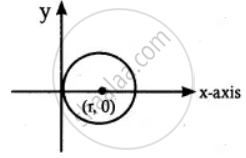Advertisements
Advertisements
प्रश्न
Find the differential equation of the family of circles passing through the origin and having their centres on the x-axis
उत्तर
Given the circles centre on x-axis and the circle is passing through the origin.
Let it be (r, 0) and its radius r
Equation of the circle is
(x – a)2 + (y – b)2 = r2
(x – r)2 + (y – 0)2 = r2
x2 – 2xr + r2 + y2 = r2
x2 – 2xr + y2 = r2 – r2
x2 – 2xr + y2 = 0 ........(1)
Differentiating equation (1) with respect to ‘x’, we get
2x – 2r + 2y `("d"y)/("d"x)` = 0 dx
2x + 2y `("d"y)/("d"x)` = 2r
`x + y ("d"y)/("d"x)` = r
Substituting r value in equation (1), we get
`x^2 - 2x(x + y ("d"y)/("d"x)) + y^2` = 0
`x^2 - 2x^2 - 2xy ("d"y)/("d"x) + y^2` = 0
`- x^2 - 2xy ("d"y)/("d"x) + y^2` = 0
Multiply by '_', we et
`x^2+ 2xy ("d"y)/("d"x) - y^2` = 0
Which is a required differential equation.
APPEARS IN
संबंधित प्रश्न
Obtain the differential equation by eliminating the arbitrary constants from the following equation:
y = A cos (log x) + B sin (log x)
Obtain the differential equation by eliminating the arbitrary constants from the following equation:
y2 = (x + c)3
In the following example verify that the given expression is a solution of the corresponding differential equation:
y = `"a" + "b"/"x"; "x" ("d"^2"y")/"dx"^2 + 2 "dy"/"dx" = 0`
Solve the following differential equation:
`"sec"^2 "x" * "tan y" "dx" + "sec"^2 "y" * "tan x" "dy" = 0`
For the following differential equation find the particular solution satisfying the given condition:
`(e^y + 1) cos x + e^y sin x. dy/dx = 0, "when" x = pi/6,` y = 0
Choose the correct option from the given alternatives:
The differential equation of y = `"c"^2 + "c"/"x"` is
Choose the correct option from the given alternatives:
The solution of the differential equation `"dy"/"dx" = sec "x" - "y" tan "x"`
The particular solution of `dy/dx = xe^(y - x)`, when x = y = 0 is ______.
In the following example verify that the given function is a solution of the differential equation.
`"y" = 3 "cos" (log "x") + 4 sin (log "x"); "x"^2 ("d"^2"y")/"dx"^2 + "x" "dy"/"dx" + "y" = 0`
In the following example verify that the given function is a solution of the differential equation.
`"x"^2 = "2y"^2 log "y", "x"^2 + "y"^2 = "xy" "dx"/"dy"`
Obtain the differential equation by eliminating the arbitrary constants from the following equation:
y = a sin (x + b)
Solve the following differential equation:
`"dy"/"dx" = ("2y" - "x")/("2y + x")`
Find the differential equation of family of lines making equal intercepts on coordinate axes
Find the differential equation by eliminating arbitrary constants from the relation x2 + y2 = 2ax
Find the differential equation of the family of all non-horizontal lines in a plane
The differential equation of all lines perpendicular to the line 5x + 2y + 7 = 0 is ____________.
The general solution of the differential equation of all circles having centre at A(- 1, 2) is ______.
If m and n are respectively the order and degree of the differential equation of the family of parabolas with focus at the origin and X-axis as its axis, then mn - m + n = ______.
The differential equation for all the straight lines which are at the distance of 2 units from the origin is ______.
The differential equation of all parabolas whose axis is Y-axis, is ______.
